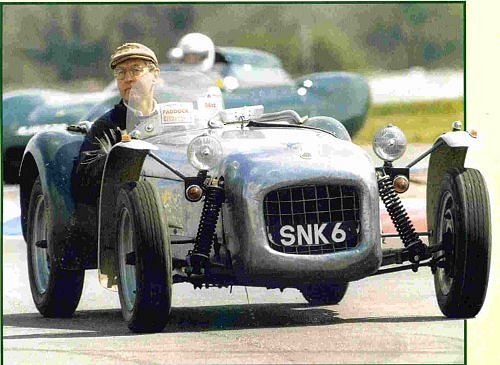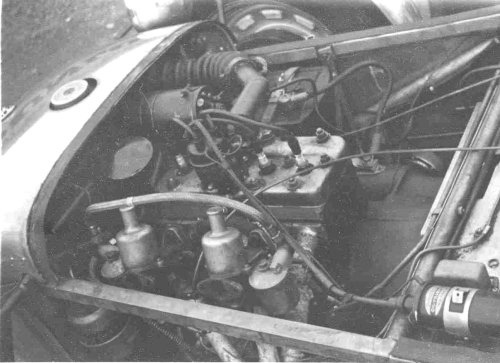
Charles Helps and Pat Dennis
 |
Historic Lotus Register | Mk VI Charles Helps and Pat Dennis |
|---|
Chatley Farmhouse
Tellisford Lane
Norton St Philip, Bath BA2 7NJ
Telephone: 01373 831351
To send e-mail click on name above
Charles is Registrar for the earliest production Lotus model,
the Mark VI, which was fitted with a variety of engines and back axles, and for which
records are particularly difficult to keep as so little was written down by the
factory in those early days.
Looking after records of the Mk VI in North America is:
3120 Lakeview Drive
Delray Beach
Florida 33445 USA
Telephone 561-637-9238
To send e-mail click on name above
Pat owns POP 444 - there is an article about the car here.
| Lotus Mark VI |
|---|
 |
| The photo shows chassis number 35 at an HLR demonstration at Thruxton circuit in Wiltshire, UK in 2001 |
The prototype Mk VI Lotus was completed in July 1952 and registered for the road on 8th July with the registration XML 6. It was fitted with a Ford Consul engine overhead valve engine with the capacity reduced to under 1500 cc (from 1508 cc) by offset grinding the crankshaft. Suspension was by split Ford beam axle and radius rod at the front giving independent suspension and a gearbox mounted torque tube located Ford rear axle with transverse panhard rod. Springs and damping were by Woodhead Monroe coil over damper units, one of the first such applications in the car world. Brakes were 10" Ford operated by cables onto Girling actuators.
Its first races were at Silverstone on 5th July and 26th July where the team managed 7 races in total with Michael and Nigel Allen, Colin Chapman and Hazel Williams all getting drives. Ecurie Lotus entered Michael Allen in the International Daily Mail 100-Mile Sports car Race organized by the West Essex Car Club meeting at Boreham in Essex on 2nd August and XML 6 practiced there on Saturday 1st. On the way back to the circuit from North London on the Sunday morning, driven by Nigel Allen, it was written off in a road accident with a bread van and never raced again. Lotus was able to claim against the other driver and received a payment from the insurance company.
However the prototype's performances at Silverstone enabled Lotus to sell replicas of the car and by 1953 several were racing with a variety of engines including Ford 1172 cc sidevalve, MG 747 cc supercharged (from an MG J4) and another Consul engined car that used the Austin gearbox from the prototype. Nigel Allen built up another car for himself using the prototype's XML 6 registration but fitted with a Ford sidevalve motor. In July 1953 the new Lotus works demonstrator, registered 1611 H, made its race debut at Goodwood driven by Colin Chapman.
When John Teychenne and David Kelsey got the order to build a second Mk VI chassis at their recently formed Progress Chassis Company at Ribblesdale Road, just round the corner from the Lotus works in Tottenham Lane, they thought that they would be lucky to get orders for five or six "by which time the market would be saturated" - Dave Kelsey. In fact helped by the new 1172 Formula series organised by the 750 Motor Club, Progress produced over 80 chassis frames for Lotus in the next couple of years.
 |
| Mark VI fitted with Ford E93A engine with remote oil filter running on twin 1 1/4" SUs and with 6V electrics |
Colin Chapman's flair for publicity also helped with loans of 1611 H being arranged for road tests by the Autocar, Autosport and Motor magazines in 1953/4 and a piece in Road and Track in the USA appearing in 1953.
The works demonstrator frame was tidied up in several ways after experience with the earlier cars, and changes to the angles of the front suspension and panhard rod fixing point at the rear improved the handling. The first few cars were individually bodied by Williams & Pritchard - even the nosecones were different. As time went on the kit of parts became more standardised although this did not prevent buyers from asking for special engine and gearbox mountings. Peter Gammon and Mike Anthony in 1954 used the MG XPAG engine, bored out to give 1466 cc, in their cars UPE-9 and NUF 100 with MG TC gearbox, Lucas Laystall aluminium alloy cylinder head and a rear axle located by twin radius rods and an A bracket on top of the differential casing. They joined Colin Chapman in his Lotus Mk VIII, competing as Team Lotus. Chapman and Gammon both finished ahead of the works Porsche of Hans Hermann in the up to 1500 cc class at the sports car race supporting the British Grand Prix in July 1954 and with Mike Anthony's help they took the Team award.
In the meantime a Mk VI trials car using a unique frame with beam front axle was completed and registered HEL 46 by Sinclair Sweeney. Although offered as an option in the Lotus sales brochure, it appears to be the only one completed. It was owned for many years by Arthur Hay and competed on some of the classic car trials.
Other engines fitted were the 2 litre, 6 cylinder BMW in a Mk VI, with a long, high bonnet power bulge to suit, and then, in 1955, the light alloy Coventry Climax engine became available and several cars used this 1100 cc engine. Mike Costin started a small division of Lotus called 'Racing Engines Ltd' supplying specially prepared engines for some Mk VI's - Pat Dennis' car C/N 39, POP 444 is fitted with one. A few cars were fitted with the Mk IX 's 11-inch diameter Lotus elektron finned brake drums with hydraulic operation and de Dion back axle.
Demand for the Lotus also came from overseas with Gunnard Rubini having chassis 26 in the USA, and with other new cars going to Canada and Australia. Jabby Crombac bought the works demonstrator 1611 H to use in France in 1954.
Official production stopped at the end of 1955 when Lotus decided to offer the Eleven alone for 1956.